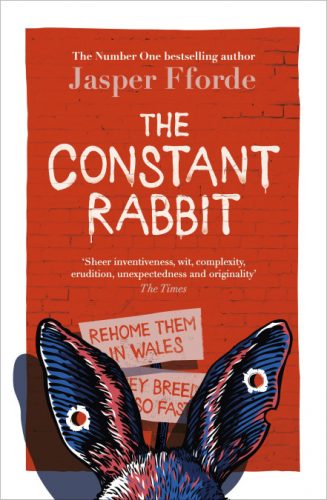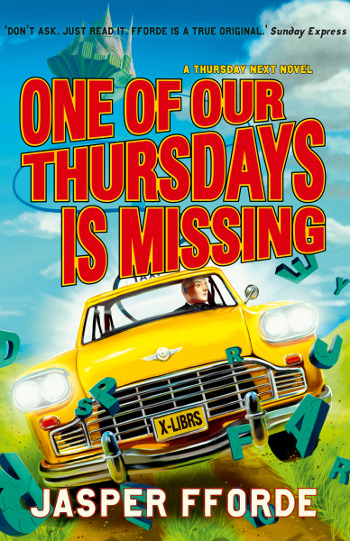
Have I mentioned before how much I love Jasper Fforde’s books?
I must have done, because they are all fantastic fun and I reviewed the fabulous ‘Early Riser’ a couple of years ago, but it’s worth stating again. These are fabulous books for anyone with a sense of humour who enjoys books about books and the vagaries of humanity.
As such, I was absolutely thrilled to be offered a copy of Jasper Fforde’s newest standalone novel, ‘The Constant Rabbit’. I was expecting a riot of wordplay, characters who frequently discuss books and a wonderful mix of the thoroughly fantastical with the resolutely mundane. I was right and this was wonderful fun.
What’s it about?
In 1965 something inexplicable happened, and no one understands what or how. This something resulted in human sized rabbits who can walk, talk and drive cars. Now it’s 2020 and after fifty five years in the UK, they are still viewed with suspicion verging on fear (if they chose to do so, their rapid breeding could create a ‘litterbomb’ that would change England forever) and many are convinced that multispeciesism is an experiment that has failed. In this increasingly hostile environment, a man meets a rabbit he once knew…
‘The Constant Rabbit’ opens on a Speed Librarying mission. Due to government cuts, libraries can only open for six minutes once a month (though the budget does stretch to funding the wages of two – two – Herefordshire Library Opening Times Compliance Officers, who are ready and waiting with their stopwatches), so Peter Knox and his dedicated team are ready to rush through their returns, loans and extensions, as soon as the Sole Librarian is in situ. Into this madness wanders a rabbit – anthropomorphised, of course – whose appearance is most perplexing, as members of the public don’t generally bother with libraries. Soon, Dewey Decimal System based insults are being traded by the (invariably middle class) Speed Librarians and library rules are being quoted by all participants in the Buchblitz.
The rabbit, identified as one Mrs Constance Rabbit, wins the argument, but when the irritated villagers of Much Hemlock realise that her family have had the temerity to move into their neighbourhood, a plan is immediately formed to ensure their rapid departure. As their next door neighbour, and a Spotter at RabCot (the Rabbit Compliance Taskforce), the villagers assume that Peter Knox will want the rabbits gone as much as they do, but Peter remembers Constance from university (before she was expelled for being a Rabbit) and he’s beginning to realise that rabbits might know more about humanity than the humans do.
Of course, all this furore over one rabbit family will surely soon be moot, because all of the 1.2 million rabbits currently residing in the UK are due to move to Megawarren in Wales imminently as part of a mass rehoming scheme. No one’s quite sure what the rabbits think about this, or maybe no-one cares, but the ruling United Kingdom Anti-Rabbit Party (UKARP) have made their decision, and Nigel Smethwick has an army ready to enforce the move…
What’s it like?
Wonderfully funny. Delightfully ridiculous – while remaining disturbingly on-point. The lives the rabbits lead are marvellous in more ways than the immediately obvious. When Constance’s husband deduces that he has a rival in his next door neighbour, he simultaneously insists upon challenging Peter to a duel, and reprimands Peter for assuming that Constance ‘belongs’ to anyone. She is with her husband until such time as she chooses not to be; he’d just rather Peter could give him a heads-up if Constance seems likely to change her choice.
This is partly so enjoyable because we get to watch a leopard change his spots. (I mean, not an actual leopard. Remember, this book features anthropomorphised rabbits…and maybe another surprise or two!) Peter Knox has never been knowingly leporiphobic, despite spending his entire adult life working to identify rabbits who are wanted for questioning (but may have committed no other crime than being a rabbit in a place like Much Hemlock), while working with other adults who are definitely leporiphobic and being fully aware that, ‘the Taskforce and UKARP and 2LG [right wing thug group called Two Legs Good] all pretty much had the same views [about rabbits]: the difference lay in legality, accountability and sanity’.
From the moment Peter re-meets Constance he is forced to put aside his previous apolitical stance (considered frightfully left wing by his community!) and begin to care about the appalling treatment of rabbits by humans and the inherent righteousness of the Rabbit Way.
While he recognised his former friend immediately in the library, it took her longer to recognise him…or did it? While Peter is perfectly willing to become a designated go-between for human-rabbit interactions, it takes quite some time for him to realise that using him as a bridge might be more than just one species’ plan…
Final thoughts
There are so many brilliant moments in this book, but I don’t want to spoil them or take them out of their perfectly fitting contexts. If you like books with a satirical, political bent and an eye on the ridiculousness of local politics and company policies, this is a gem. If you enjoy books with a bookish feel, (by which I mean characters regularly discuss their reading matter and habits,) this is perfect. Basically, if you’ve got a sense of humour and do not suffer from leporiphobia, or related diseases, then you should probably read this book.
Recommended.
‘The Constant Rabbit’,
Jasper Fforde,
2020, Hodder & Stoughton, hardback
Many thanks to the publicist and publishers for providing me with a copy of this book in exchange for an honest review.
My reviews of a selection of Fforde’s other books can be found here:


